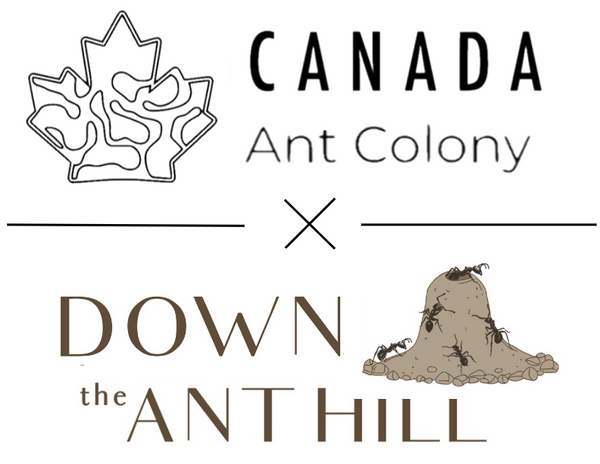Likely originating from Eastern Canada and the United states, these little black ants are easily recognizable by their heart shaped gaster. These ants are very widespread and are deemed present in every state except 5: Washington, Oregon, Nevada, Iowa and Kentucky These ants love nesting beside sidewalks and they are easy to keep in captivity. They are very fun to watch and grow at a decently quick rate.
You can find them for sale in Canada from Canada Ant Colony here or in the United States from Stateside Ants here
Taxonomy
Family: Formicidae
Subfamily: Myrmicinae
Tribus: Crematogastrini
Genus: Crematogaster
Species: Crematogaster cerasi

Crematogaster cerasi (Acrobat Ant) queens and workers
Basic info
Origin: Easter Canada and United States
Habitat: These ants live beside sidewalks and do enjoy warm temperatures but do not require them.
Colony form: Strictly monogynous.
Colony size: 10.000+ workers
Colony age: 5-15 years
Founding: Fully claustral
Nesting: They nest under rocks and in dirt, as well as underneath or beside sidewalks. It is suspected they do this because the cement conducts heat into the nest.
Workers: Monomorphic
Hibernation: These ants require at least 0-3 months and a half of hibernation in 4-6 degrees celsius. (0 months in southern states like California)
Reproduction: Nuptial flights throughout August and September.
Appearance
Workers: Workers are a medium to small size with a full black/dark brown body and a beautiful heart shaped gaster.
Queens: The ants are completely black with a oval gaster that has a pointy tip at the end. Their legs are black/brown and they have a black head.
Drones: The drones are fully black and have translucent wings.

Certain populations of acrobat ants are polygynous, or have multiple queens
Size
Workers: 2.6-4mm in length (depending on the colonies worker count)
Queens: 7-8mm
Drones: around 3-5mm
Development time at 75°F (24°C)
Egg to larvae: around 8 days
Larvae to pupa: around 11 days
Pupae to worker: Around 9 days
Egg to worker: 28 days
Antkeeping information
Recommendation: Beginner-Intermediate (these ants need to hibernate before laying their eggs (not the case in southern states like California) so that isn’t very simple, however once you reach past that diapause they are easy to raise).
Temperature: 14-29° Celcius
Humidity: Outworld: room humidity, Nesting area: relatively moist
Nest types: As they nest in dirt and under stones and by the sidewalk, sand-clay farms, acrylics and 3D-printed nests (preferably with a bottom coat of sand-clay or grout) will work fine. Does also well in a natural setup (soil) but the setup should have a large stone so they can nest under it.
Formicarium size: Should fit the current colony size. Crematogaster ants are very fast growers so prepare to expand.
Formicaruim accessories: Heat source (optional).
Substrate type: This species can walk well on most surfaces. Glass, vinyl tubing, acrylics, sand and clay pose no issues. They can also climb vertical and upside down on glass and due to the mass of workers larger colonies can quickly walk off certain barriers (baby powder in particular) so escape barriers need to be checked regularly and replaced if needed.

Acrobat Ant Queens Under a Rock
Behaviour
These ants remind me a lot of Tetramorium immigrans, they grow pretty quickly, they are aggressive ants who really enjoy their protect. However unlike Tetramorium these ants do not sting which makes them much more manageable and much more interesting to hunt. They spread their pray out and bite it to death.
These strong little ants are active during the day and are quite curious. They are not shy but they aren't overly aggressive, they found a happy medium. They will however fight off invaders with everything they have, they won’t cover and hide.
Additional information
Crematogaster cerasi’s pointy gaster shape is very original. That is why I find it enjoyable to keep them in a acrylic nest with a white background to really see their gaster shape. It contrasts well against the white.
The workers are quite average when it comes to foraging. They do not travel incredible distances but watching them feed is still interesting, especially when they drag prey back to their nest.
Crematogaster cerasi do very well in both ytong and acrylic nest. It is really up to the owner to pick which ones they personally prefer. I would avoid plaster and grout however.
If you’re putting them into a natural set up, put your lighting outlet near the glass to produce heat and they will nest beside it! Also add a tun of rocks for them to nest under.
Crematogaster ants are one of the few animal genuses on Earth that can produce foaming toxins. When they attack they excreet a tiny droplet of toxin, bend their abdomen over their head and use their brush-like stinger to paint it onto the target where it starts to turn into acidic foam. This is particularly devastating against other arthropods.
When agitated Crematogaster workers raise their pointy gasters high in the air which makes this genus rather easy to identify.
Diet
Sugars
Crematogaster cerasi really enjoy a very wide oray of food. They absolutely love their honey and I find they also go crazy for ketchup, maple syrup and melted ice cream. Also having a sugar/honey water test tube in their outworld is always beneficial.
Protein
They enjoy almost anything you give them. I find they particularly like Dubia cockroaches however as those are not available for many US citizens, my alternative option was darkling beetles and morio beetles. They’ll eat any other bug as well tho except for phoenix worms for some reason.

Acrobat ants eating an insect
This guide was compiled and written by Daniel Cantin of the 'Ants and Antkeeping' discord server, which can be found here. https://discord.gg/YbZGvtR3
This guide has been posted with the permission of the authors. The original article may be found here. I have also made some edits based on my own observations
